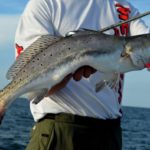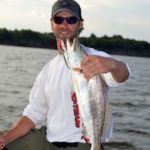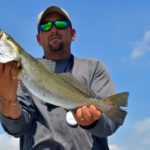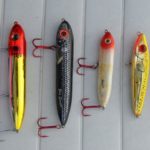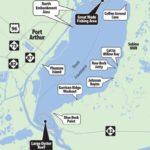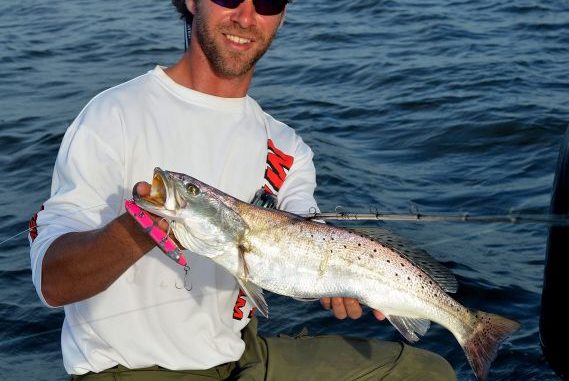
In July, trout anglers don’t have to resort to catching schoolies under popping corks. Head to Sabine Lake and put these experts’ tips to the test for big trout.
Adam Jaynes of Orange, Texas, knows how to beat the heat to get on a great topwater bite in the summer.
Last July, he and a client quietly slipped off the sides of his boat at 4 a.m. to wade into shallow waters above sand flats near the edge of the Intracoastal Waterway in Sabine Lake.
“I chose this area because it was holding just a huge concentration of mullet,” the 27-year-old Jaynes said. “These baitfish were moving well and jumping, and there were slicks everywhere. We started casting on the edges of the school of baitfish with black Heddon Super Spooks. The fish were blowing up on the lures as soon as we started working them.
“We just hammered them that morning.”
Dog-walking their topwaters, the anglers picked up 30 trout and a dozen redfish.
“It was quality all morning,” he said. “Our largest trout weighed 8 pounds, and we had three others over 7. We caught three more between 6 and 7 pounds, and the rest were 3- and 4-pounders. We also released all these fish.
“It was my best trip by far in July of last year.”
Jaynes admitted that trip was exceptional and not the norm on Sabine Lake, but he said quality fish are far from rarities on the system.
“During your typical early morning bite in July on Sabine, you can catch trout ranging from 3 to 5 pounds, with an occasional big fish weighing 6 pounds or better,” he said. “This lake holds great trout in July, although most anglers will specifically focus on catching the smaller schooling trout under birds.”
Another angler, Sulphur’s Robby Trahan, will also be found working topwaters as he follows the migration of schools of pogies from midlake northward to Coffee Ground Cove. Speckled trout and a host of other species will be following on the heels of these baitfish.
A year ago, Trahan and his son, Noah — along with Trahan’s brother, Justin — enjoyed an afternoon of nonstop topwater action while casting spectrum Heddon Spook Jrs.
“The lake had flattened out, and there were ladyfish, gafftops and trout working the pogies,” Trahan said.
“We found an acre of water where a lot of fish were just blowing up on top. We pulled up near the edges, and we caught 45 really good trout.”
The “really good trout” to which Trahan was referring ranged from 2 to 6 pounds, although the angler complained about having to continuously contend with ladyfish and gafftops attacking the lures.
Some anglers might find wading for speckled trout at 4 in the morning a bit on the extreme side.
Such opinion is certainly not shared by Jaynes. Well before daylight, the angler finds baitfish and trout moving very well as they migrate from the deeper sections of Sabine Lake to the shallows.
Jaynes, who is well-known for targeting quality and trophy trout in Sabine Lake, said that early morning approach is key to his catching numbers of 5- to 9-pound fish.
“Trout — especially the big ones — can be extremely difficult to catch in the middle of the day,” he said. “And before daybreak, there’s more light on the water’s surface than people think. The moonlight alone can cast good light, and there’s also the illumination and glare from the chemical plants bordering the lake. That’s all good unless it’s foggy out there.
“Also, there’s certainly a lot less pressure from other anglers when fishing.”
Jaynes said it’s important to be aware of any fish-spooking lights: He allows anglers to use small headlights attached to their caps only when tying knots on lures or working a fish.
“These trout can be larger and older fish, and they are even more sensitive to sound and any type of sensation that they don’t normally encounter in their habitat,” he said. “That’s also why we wade. There’s less movement and less noise because you can’t drift over the trout and bait, and disturb them like you can in a boat.
“It’s also much cooler for the anglers at such an early time.”
By contrast, Trahan almost always fishes from his Frontier bay boat. He controls the distance from the trout and baitfish activity by stopping his trolling motor, and slowly and quietly drifting on the edges of the schools.
“You don’t want to get too close,” he said. “The bite can turn off real quick if you motor into them.”
As for his preferred topwater lures, Jaynes and anglers under his direction will cast 5-inch Super Spook in black, pink/gold and clown colors in the predawn darkness.
“In the dark, the size of that lure presents a big profile on the water’s surface, making it easier to see from the trout’s point of view,” Jaynes said. “At 8 a.m., I’ll then switch over to the smaller version — the 3 ½-inch Super Spook Jr. — to match the actual size of finger mullet and pogies.”
As the day progresses, he also casts MirrOlure’s She Dogs.
And Jaynes ties a loop knot on all of his topwaters so the lures can work most effectively.
“The loop knot is a standard here used by wading anglers from Calcasieu Lake westward through Texas,” he said. “This knot allows the bait to move freely, enabling the side-by-side dog-walking action of the lure to be even more effective in attracting trout.”
The angler also emphasized the advantages of making long casts well away from human activity, whether in the water or on the decks of a boat.
“I’ll use 30-pound Windtamer FINS braid with a 30-pound Berkley Big Game monofilament leader, resulting in great casting distance with line sensitivity to feel very subtle taps,” he said.
But rod selection is the most-important consideration when pursuing quality and trophy specks, Jaynes said.
“I currently use a Sarge rod — the medium/fast-action Free Bird, which is a custom, super-light rod weighing only 2 ½ ounces,” he said. “Its blended components make it very sensitive to bites, and you also end up with a lot less wrist fatigue from dog-walking topwaters.”
Whether it’s trout, redfish or bass, any serious angler contemplating using topwater lures must learn the walk-the-dog technique, although Jaynes has an unorthodox approach to the tactic.
Most anglers who use topwaters retrieve their lure with sweeps and twitches from their rod tips pointed down.
“I’ve always worked that rod tip straight up and down,” Jaynes said. “And I work the lure by varying the speed and the length of the sweep and adjusting the slack. If I want it to work wide left and right, I’ll retrieve it slowly and pop the rod a little higher.
“It works for me.”
Trahan fishes daylight hours with family and clients, and they will dog-walk his favorite topwater lures: Heddon’s bone/chrome Super Spook and the spectrum Spook Jr.
Like Jaynes, Trahan will use very lightweight Sarge custom rods. His reels will be spooled with 15-pound Floroclear P-Line.
Contact information
For more information, Capt. Adam Jaynes can be reached at (409) 988-3901 or by visiting his website at www.justfishsabine.com.
Capt. Robby Trahan’s contact cell number is (337) 309-7881, and the address of his website is www.fishingsabinelake.com.

